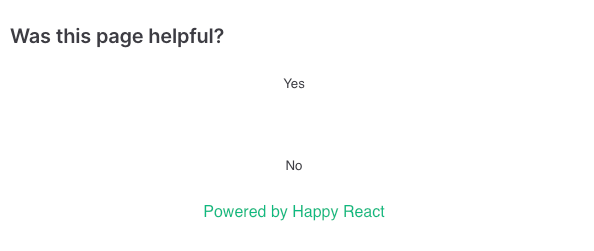Integrating with VitePress
Install VitePress
According to official documentation (opens in a new tab) of installing vitepress is by running following command:
npm install -D vitepressthen you need to run following command to setup VitePress in your project:
npx vitepress initYou will be asked bunch of baisc questions about your project.
Install package
HappyReact provides Vue package to install from the npm registry. This will let you add more control over how you load the feedback widget. For example, you can defer loading it to have a better web vitals score.
npm install @happyreact/vue Project setup
Create a new project in the dashboard
Go to New project (opens in a new tab) and choose the name of the project eg. Docusaurus. You can always change it later.
Add two reactions: "Yes" and "No"
Go to the Docusaurus project > Reactions tab. Click in "+ Add new reaction" and fill the "Icon" input with Yes.
Remove $count text from the "Label" input.
After that, make same steps with No reaction.
Adjust project settings
Every domain where you will use the feedback widget needs to be on the whitelist. This applies also to development and staging
domains. Make sure you include port in localhost domain eg. http://localhost:3000.
Mark the option "Allow multiple reactions" and set the "Max reactions" to 0 in settings.
Let's make our feedback component
Now we need to adjust our Feedback code:
<script setup>
import { reactive } from 'vue';
import { Widget } from '@happyreact/vue';
import '@happyreact/vue/theme.css';
const props = defineProps(['resource']);
const state = reactive({ reaction: null });
function handleReaction(params) {
state.reaction = params.icon;
}
</script>
<template>
<h3>Was this page helpful?</h3>
<div v-if="state.reaction">
<span v-if="state.reaction === 'Yes'">
Thanks for your feedback. We are glad you like it :)
</span>
<span v-else> Thanks for your feedback. We will try to improve :( </span>
</div>
<Widget
v-else
token="[token]"
:resource="props.resource"
:onReaction="handleReaction"
/>
</template>Make sure you replace [token] with created project token
Add our created feedback component on the bottom of every page. Unlike, for example in docusaurus you need to manually add component at every documentation page.
<script setup>
import Feedback from '../components/Feedback.vue'
</script>
# VitePress 💙 StackBlitz
Hi there :wave: This is a demo running VitePress within your **browser tab**!
## Powered by Vite
VitePress uses Vite under the hood. This means:
- Instant server start
- Lightning fast HMR
- Optimized builds
## Markdown-Centered
So you can focus more on writing. Powered by MarkdownIt. Comes with many [built-in extensions](https://vitepress.vuejs.org/guide/markdown), and you can use Vue features in Markdown too!
<Feedback resource="example" />The result, for now, should be this:

Now let's make our styles component. Add this inside Feedback.vue file at the bottom of the file.
CSS should be placed between <style></style> tags.
.title {
font-size: 24px;
font-weight: bold;
text-align: center;
margin-bottom: 15px;
}
.hr-grid {
display: flex;
flex-direction: row;
justify-content: center;
min-height: 50px;
}
.hr-cell {
width: 50px;
}
.hr-reaction {
width: 100%;
border: black 1px solid;
}
.hr-reaction:hover {
border: black 1px solid;
}Congrats 🥳 You made it and you should see final result:
